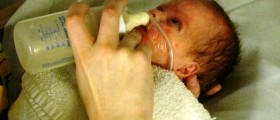
Rett syndrome is medical condition which can be characterized as neurodevelopmental type of disorder which affects the grey matter of the brain. The most peculiar fact concerning this type of medical condition is that it affects females almost exclusively. Those who suffer are usually pretty much prone to different types of gastrointestinal disorders and in most cases this type of medical conditions involves the occurrence of seizures. The patients suffering from Rett syndrome usually have no verbal skills. A big issue with this medical condition is that because it may include autism and cerebral palsy it can easily be confused with another syndrome called Angelman syndrome. The syndrome got its name from Andreas Rett who was an Austrian pediatrician who first described the syndrome back in 1966.
Development and Signs
The average development process of the Rett syndrome is commonly quite normal during the first 18 months which involves certain early indicators and subtle developmental deviations. Once this initial process of development is over it is followed by a certain regression in the development which includes decelerated head growth rare, loss of purposeful hand use and the overall regression of the motor and language milestones. This period of regression commonly involves certain signs and symptoms which can easily be mistaken for autism, so one should be extra careful not to mix two different medical conditions. The most common ones include certain sensory problems, problems with coordination and balance, loss of speech, markedly impaired use of nonverbal behaviors to regulate social interaction, general lack of interest, lack of emotional reciprocity, lack of social reciprocity, avoidance of eye contact, inconsolable crying, panic attacks and screaming fits. There are also certain types of signs and symptoms of the Rett syndrome which may be present in cerebral palsy. Regression described above cannot be associated with cerebral palsy, so confusion with other medical conditions usually does not occur. These types of symptoms may include grinding of teeth (which is medicinally referred to as bruxism), dystonia, spasmodic movements of hand or facial muscles (medicinally referred to as cheora), some forms of spasticity, various different types of gastrointestinal problems, abnormally small head, poor head growth (medicinally referred to as microcephaly), ataxia, movement difficulties, gait, absent ability to walk, delayed ability to walk, hypotonia, malnutrition triggered by difficulty swallowing and short stature which may also sometimes be accompanied by unusual body proportions. There are cases of Rett syndrome in which all signs may remain stable for decades, especially the ones associated with cognitive functions and interactions. Persons who once suffered from asocial behavior may switch to highly social behavior. Some patients may also develop slower than normal motor functions such as dystonia and rigidity. Most cases of Rett syndrome also involves different forms of seizures characterized by different levels of severity, depending on the individual case. Some cases of Rett syndrome may also involve scoliosis which can only be dealt with by performing a corrective surgery.
Causes of Rett Syndrome
Rett syndrome is commonly caused by the mutations which occur in the gene known as MECP2. This gene is located on the X chromosome and these mutations can be germline or sporadic. Some rare cases of Rett syndrome are triggered by genetic mutations in some other genes, namely the CDKL5 and the FOXG1 genes. Some even rare cases of the Rett syndrome do not involve any gene mutations at all. Germline mutations are the ones which are inherited from normal mothers which had a mutation in the MECP2 which is the gene encoding methyl CpG Binding protein 2. These types of mutations occur only in less than 5 percent of all cases of Rett syndrome. The biggest number of cases of Rett syndrome are caused by sporadic mutations. These mutations are triggered by a completely new mutation which occurs in the child for the first time ever without being inherited from either parent. These cases of de novo mutations which occur for the first time are commonly derived from the male copy of the X chromosome. There are also certain pontine noradrenergic deficits which may be associated with the development of the Rett syndrome. People who suffer from this medical condition are known for having significantly lower levels of norepinephrine in the brain than the general public. The genetic mutations described earlier can be held responsible for the certain changes which take place in the locus coeruleus. Such changes commonly include decreased functioning of its noradrenergic innervations accompanied by hyperexcitability. There are also certain midbrain dopaminergic disturbances which may be held responsible for the development of the Rett syndrome. Dysregulation of the nigro striatal pathways is causative from certain diseases in humans and it can often be characterized by certain forms of motor impairment such as the hypokinesia, bradykinesia and hypotonia, among others. In some cases, such motor abnormalities worsen until the death of the patient.

















Your thoughts on this
Loading...